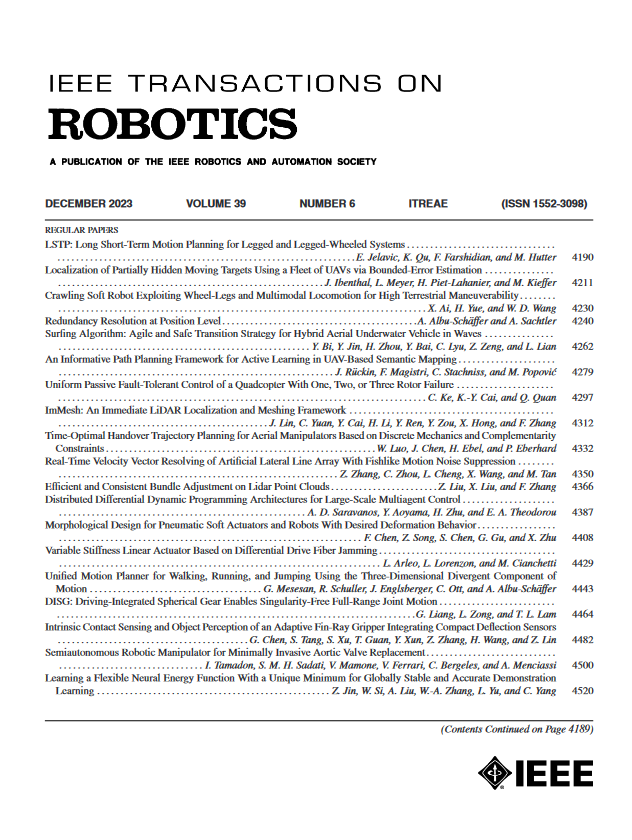Versatile Tasks on Integrated Aerial Platforms Using Only Onboard Sensors: Control, Estimation, and Validation
IF 9.4
1区 计算机科学
Q1 ROBOTICS
引用次数: 0
Abstract
Connecting multiple aerial vehicles to a rigid central platform through passive spherical joints holds the potential to construct a fully actuated aerial platform. The integration of multiple vehicles enhances efficiency in tasks like mapping and object reconnaissance. This article proposes a control and state estimation framework for the integrated aerial platform (IAP), enabling it to perform versatile tasks like object reconnaissance and physical interactive tasks with only onboard sensors. In the framework, the 6-D motion control serves as the low-level controller, while the high-level controller comprises a 6-D admittance filter and a perception-aware attitude correction module. The 6-D admittance filter, serving as the interaction controller, is adaptable for aerial interaction tasks. The perception-aware attitude correction algorithm is carefully designed by adopting a geometric model predictive controller (MPC). This algorithm, incorporating both offline and online calculations, proves to be well-suited for the intricate dynamics of an IAP. A 6-D direct wrench controller is also developed for the IAP. Notably, both the interaction controller and the direct wrench controller operate without reliance on force/torque sensors. Instead, a wrench observer algorithm is devised, considering external disturbances. In addition, based on the kinematics constraints of the multiple aerials in the platform, a fusion algorithm for multiple visual-inertial odometry and kinematics constraints is developed, providing more accurate localization. A prototype of the IAP is constructed, and its capabilities are demonstrated through experiments including perception-aware object reconnaissance, aerial mapping, aerial peg-in-hole task, and 6-D contact wrench generation. All experiments are conducted exclusively with onboard sensors. These tasks exemplify the merits of the proposed IAP and validate the effectiveness of the proposed control framework and fusion algorithm.集成空中平台上的多功能任务:仅使用机载传感器:控制,估计和验证
通过被动球面接头将多个飞行器连接到刚性中心平台,有可能构建一个全驱动的空中平台。多辆车的集成提高了测绘和目标侦察等任务的效率。本文提出了一种集成空中平台(IAP)的控制和状态估计框架,使其能够仅使用机载传感器执行多种任务,如物体侦察和物理交互任务。在该框架中,6维运动控制作为低层控制器,高层控制器由6维导纳滤波器和感知姿态校正模块组成。6维导纳滤波器作为交互控制器,适用于空中交互任务。采用几何模型预测控制器(MPC)精心设计了感知感知姿态校正算法。该算法结合了离线和在线计算,被证明非常适合IAP的复杂动态。还为IAP开发了6-D直接扳手控制器。值得注意的是,交互控制器和直接扳手控制器都不依赖于力/扭矩传感器。设计了一种考虑外部干扰的扳手观测器算法。此外,基于平台中多天线的运动学约束,提出了一种多视惯性里程计与运动学约束的融合算法,提供了更精确的定位。构建了IAP原型,并通过感知感知对象侦察、航空测绘、航空钉入孔任务和6-D接触扳手生成等实验验证了其功能。所有的实验都是用机载传感器进行的。这些任务举例说明了所提出的IAP的优点,并验证了所提出的控制框架和融合算法的有效性。
本文章由计算机程序翻译,如有差异,请以英文原文为准。
求助全文
约1分钟内获得全文
求助全文
来源期刊

IEEE Transactions on Robotics
工程技术-机器人学
CiteScore
14.90
自引率
5.10%
发文量
259
审稿时长
6.0 months
期刊介绍:
The IEEE Transactions on Robotics (T-RO) is dedicated to publishing fundamental papers covering all facets of robotics, drawing on interdisciplinary approaches from computer science, control systems, electrical engineering, mathematics, mechanical engineering, and beyond. From industrial applications to service and personal assistants, surgical operations to space, underwater, and remote exploration, robots and intelligent machines play pivotal roles across various domains, including entertainment, safety, search and rescue, military applications, agriculture, and intelligent vehicles.
Special emphasis is placed on intelligent machines and systems designed for unstructured environments, where a significant portion of the environment remains unknown and beyond direct sensing or control.
 求助内容:
求助内容: 应助结果提醒方式:
应助结果提醒方式:


